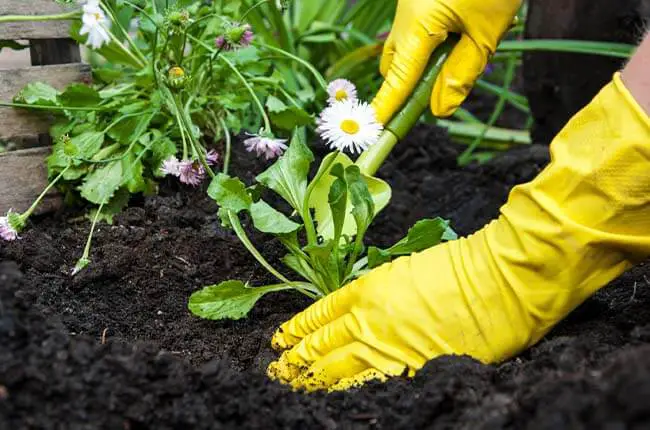When compost smells bad like garbage, rotten eggs, or even poop, it has turned anaerobic.
But can you still use it for plants?
It is not recommended to use smelly compost, especially for edible plants, because it can carry pathogens, ammonia, and alcohol that can hurt plants. Also, it may contain weed seeds.
Here are the problems associated with anaerobic compost:
1. Ammonia toxicity
When organic matter is decomposed under low oxygen or anaerobic conditions, the nitrogen in organic compounds cannot be efficiently converted to nitrate (NO₃-) or other forms, leading to the production and accumulation of ammonia (NH₃).
Not only that Ammonia cannot be used directly by plants. Low ammonia levels can also cause burning on young leaf margins, and high concentrations can be toxic for plants, especially acid-loving plants such as Azaleas.
2. Alcohol
Smelly compost often contains a low level of methyl alcohol because it is not fully decomposed.
Alcohol is produced when simple sugars in green organic waste are fermented. It can severely dehydrate and ultimately kill plants.
Apart from alcohol, some organic acids are produced during decomposition and are toxic to plants.
3. Water retention
Anaerobic compost holds more water and because it is decomposed under low oxygen conditions, the lack of air in the soil can suffocate plants with soil roots.
4. pH
Anaerobic compost is very acidic, although it can vary depending on the initial materials used. It can help to acidify or neutralize alkaline soils, which is beneficial for acid-loving plants. However, for most plants, the high acidity can damage plant roots.
5. Pathogens
While both the aerobic and anaerobic types of composting can harbor pathogens (bacteria, viruses, and parasites), the risk may be higher with anaerobic composting because it cannot reach temperatures high enough (above 131°F or 55°C) to kill the pathogens. Using such compost, especially on edible plants, might present health risks.
Pathogens that may be more likely to survive in anaerobic compost include:
Salmonella and E. coli: Such bacteria can be present in compost that contains animal waste. Some strains of E. coli are more tolerant of anaerobic conditions and can cause serious illness if they contaminate food crops.
Clostridium perfringens: Such bacteria produce resistant spores that can survive in harsh conditions. They are one of the most common causes of food poisoning.
Listeria: Such bacteria are more tolerant of the low-oxygen conditions of the anaerobic composting process and can cause a serious infection known as listeriosis.
Certain parasites: Some parasites, such as those that cause giardiasis or cryptosporidiosis, produce cysts that can survive in harsh conditions, including low-oxygen environments.
Certain viruses: Some viruses can also survive the composting process, particularly if it’s not done correctly.
6. Weeds
Because of a lack of high composting temperatures, weed seeds may not be fully eradicated, and you could be introducing weeds to your garden if anaerobic compost is used.
7. Bad smell
And, the most obvious: the smell.
During anaerobic composting, carbon-rich organic materials are broken down by microorganisms, producing strong odors of ammonia and hydrogen sulfide, the smell of rotten eggs.
The strong smell is not only unpleasant; it can also attract flies and pests that may introduce plant diseases.
Can smelly compost benefit plants?
Anaerobic compost does contain some nutrients for plants, but it takes longer to release them than under aerobic decomposition.
A study shows that both composting processes resulted in the same quantity of macronutrients for plants, namely Nitrogen, Phosphorous, and Potassium. However, decomposing under anaerobic conditions took 18 days, or 5 days more, to release the nutrients in the compost compared to the aerobic composting process (Muliyadi, 2021).
Anaerobic compost does contain some plant nutrients, especially nitrogen, which is essential for plant growth and plays a vital role in photosynthesis and protein synthesis.
A study found that anaerobic compost can increase the production of lettuce by 52% compared to unfertilized ones (Montemurro et al., 2010).
Besides macronutrients, anaerobic compost also contains trace elements that are necessary for healthy plant development.
Apart from nutrients, smelly compost can improve the water retention capacity of sandy soils.
Final words
The major problem with using stinky compost in the garden and for plants is not just its unpleasant smell. The problem is that it often contains substances that can hurt plant growth.
If you consider using it, it should be for improving soil fertility instead of growing plants.
Also, consider fixing the stinky compost pile by aerating it. Read this article to learn more ways how to fix anaerobic compost. It can be fixed but it could take a few months to remove the smell.
Happy gardening!
Related
7 Ways To Fix Stinky Anaerobic Compost (Easy!)
References
F. Montemurro, D. Ferri, F. Tittarelli, S. Canali & C. Vitti (2010) Anaerobic Digestate and On-Farm Compost Application: Effects on Lettuce (Lactuca sativa L.) Crop Production and Soil Properties, Compost Science & Utilization, 18:3, 184-193, DOI: 10.1080/1065657X.2010.10736954 (https://www.tandfonline.com/doi/abs/10.1080/1065657X.2010.10736954)
Muliyadi, Dwi Wahyu Purwiningsih (2021). NPK Level in Anaerobic and Aerobic Composting Using Spoiled Rice MOL. STRADA Jurnal Ilmiah Kesehatan, vol. 10(1), pp.817-825
- Top 6 Drip Irrigation Systems for Raised Beds (2025) - January 31, 2025
- Top 10 Orchid Fertilizers: A Comprehensive Review (2025) - January 16, 2025
- Top 6 Slow-Release Fertilizers for Houseplants & Veggies (2025) - January 15, 2025

